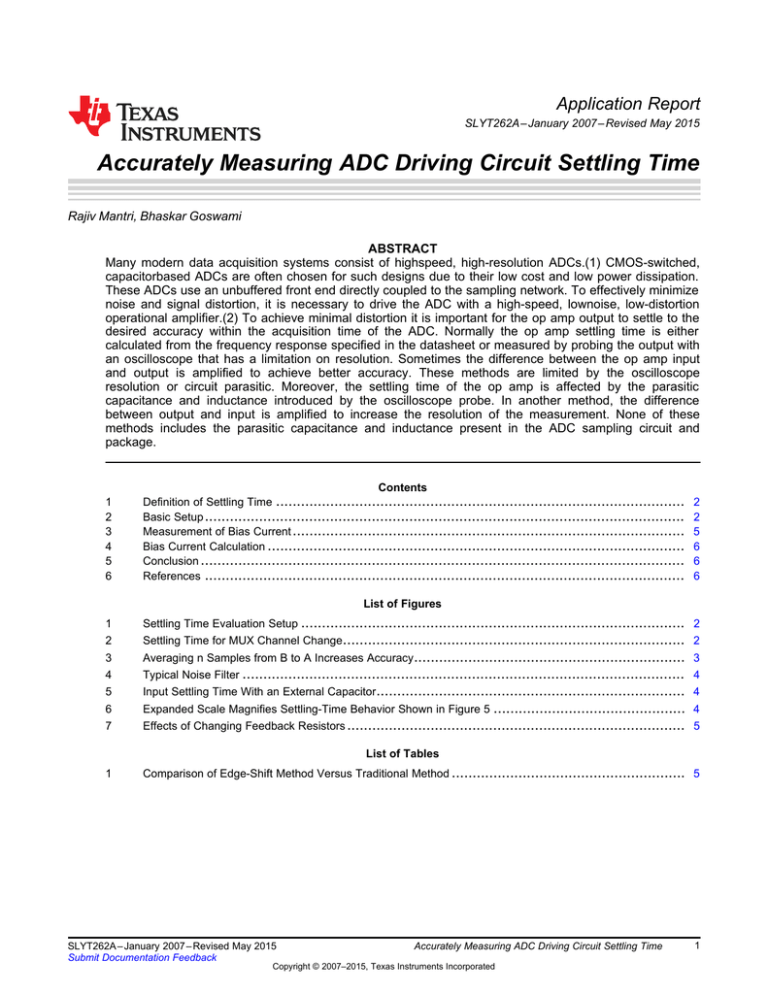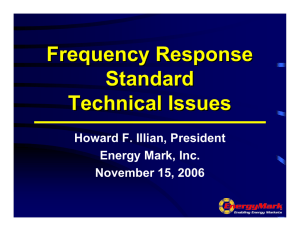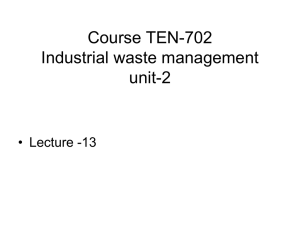Accurately measuring ADC driving-circuit settling time (Rev. A) PDF
advertisement

Application Report SLYT262A – January 2007 – Revised May 2015 Accurately Measuring ADC Driving Circuit Settling Time Rajiv Mantri, Bhaskar Goswami ABSTRACT Many modern data acquisition systems consist of highspeed, high-resolution ADCs.(1) CMOS-switched, capacitorbased ADCs are often chosen for such designs due to their low cost and low power dissipation. These ADCs use an unbuffered front end directly coupled to the sampling network. To effectively minimize noise and signal distortion, it is necessary to drive the ADC with a high-speed, lownoise, low-distortion operational amplifier.(2) To achieve minimal distortion it is important for the op amp output to settle to the desired accuracy within the acquisition time of the ADC. Normally the op amp settling time is either calculated from the frequency response specified in the datasheet or measured by probing the output with an oscilloscope that has a limitation on resolution. Sometimes the difference between the op amp input and output is amplified to achieve better accuracy. These methods are limited by the oscilloscope resolution or circuit parasitic. Moreover, the settling time of the op amp is affected by the parasitic capacitance and inductance introduced by the oscilloscope probe. In another method, the difference between output and input is amplified to increase the resolution of the measurement. None of these methods includes the parasitic capacitance and inductance present in the ADC sampling circuit and package. 1 2 3 4 5 6 Contents Definition of Settling Time .................................................................................................. Basic Setup ................................................................................................................... Measurement of Bias Current .............................................................................................. Bias Current Calculation .................................................................................................... Conclusion .................................................................................................................... References ................................................................................................................... 2 2 5 6 6 6 List of Figures 1 Settling Time Evaluation Setup ............................................................................................ 2 2 Settling Time for MUX Channel Change.................................................................................. 2 3 Averaging n Samples from B to A Increases Accuracy ................................................................. 3 4 Typical Noise Filter .......................................................................................................... 4 5 Input Settling Time With an External Capacitor.......................................................................... 4 6 Expanded Scale Magnifies Settling-Time Behavior Shown in Figure 5 .............................................. 4 7 Effects of Changing Feedback Resistors ................................................................................. 5 List of Tables 1 Comparison of Edge-Shift Method Versus Traditional Method ........................................................ 5 SLYT262A – January 2007 – Revised May 2015 Submit Documentation Feedback Accurately Measuring ADC Driving Circuit Settling Time Copyright © 2007–2015, Texas Instruments Incorporated 1 Definition of Settling Time 1 www.ti.com Definition of Settling Time Settling time is the time elapsed from the application of an ideal instantaneous step input to the time at which the closed-loop amplifier output has entered and remained within a specified symmetrical error band. Settling time includes a very brief propagation delay, plus the time required for the output to slew to the vicinity of the final value, recover from the overload condition associated with slewing, and finally settle to within the specified error. For high-resolution ADCs, the specified error band is usually one fourth of one least significant bit (LSB) of the ADC. 2 Basic Setup The ADC used here is the Texas Instruments (TI) ADS8411, which is a 16-bit, 2-MSPS successive approximation register (SAR) ADC. The driver op amp is the TI THS4031. Figure 1 shows the evaluation setup. The instantaneous step input is generated with an analog multiplexer (MUX) (the TI TS5A3159) by switching its two channels. A dc voltage, V, is applied to channel 2, and channel 1 is connected to ground; so this setup can produce a step input rising to V from 0 or falling to 0 from V. Alternatively, the step input can be generated from any step generator. The step generator should settle much faster than the op amp settling time. 2.1 Explanation Step 1 ADC samples channel 1 (connected to ground) first. A long sampling time is provided to make sure that the input capacitor of the ADC is fully discharged. Step 2 The analog MUX is switched to channel 2 from channel 1 at instant A in Figure 2. This diagram shows the voltage at point S (Figure 1) when the MUX switches over to channel 2 from channel 1. The settling time of the MUX is denoted by ts. It is assumed that ts is much shorter than the op amp settling time. Pattern Generator Conversion Start AdjustableDelay Generator Channel 1 Grounded ts S Channel 2 Voltage, V THS4031 Op Amp ADS8411 16-Bit, 2-MSPS ADC TS5A3159 Analog MUX Figure 1. Settling Time Evaluation Setup 2 Accurately Measuring ADC Driving Circuit Settling Time MUX Channel 1 MUX switches to channel 2 here Channel 2 A Figure 2. Settling Time for MUX Channel Change SLYT262A – January 2007 – Revised May 2015 Submit Documentation Feedback Copyright © 2007–2015, Texas Instruments Incorporated Basic Setup www.ti.com Step 3 Once the analog MUX is switched at instant A, the input of the op amp starts changing. The output of the op amp starts changing after a very brief propagation delay after instant A. The op amp settling time (tideal) is approximately calculated from the slew rate and bandwidth specified in the op amp datasheet. The method proposed here plots the op amp output from instant A to instant B (Figure 3). The time difference between instant B and instant A is 2tideal. Sampling starts here B A Op Amp Output Sampling edge is shifted toward left MUX Output Figure 3. Averaging n Samples from B to A Increases Accuracy Step 4 The first ADC sampling edge appears at instant B, and n number of readings (digital outputs from the ADC) are taken. The n number of readings are averaged for better accuracy (discussed later). Next the sampling edge is shifted to the left by 1 ns (Figure 3) with the help of a pattern generator and an adjustable-delay generator (Figure 1), and again n number of readings are taken. This way the sampling edge is shifted toward the left from instant B to instant A in 1-ns steps. At each sampling edge the average is stored in an element of an array. The array is plotted against the time to get the true picture of the op amp output settling (Figure 3). 2.2 Averaging to Achieve Better Resolution Input of an n-bit ADC should settle to at least n+2 bits, but measured output is an n-bit digital code from the ADC. The resolution can be increased by repeatedly sampling the same input and taking multiple (n) readings from the ADC. Finally an average is taken on the n digital output codes. It can be shown that for each additional bit of resolution, the number of readings should be 4, so w extra bits of resolution require 4w readings. For each additional bit, the signal-to-noise ratio (SNR) increases by 6.02 dB. In this case the 16-bit ADC should settle with at least 18-bit accuracy. SNR = 6.02 × N + 1.76, where N is the ADC resolution. SNR is 110.08 dB for 18-bit accuracy, so an extra bit (w) of resolution required is: 110.08 – 86* / 6.02 = 4 * Typical SNR specification of ADS8411 The number of samples (n) needed for each reading is 44 = 256. SLYT262A – January 2007 – Revised May 2015 Submit Documentation Feedback Accurately Measuring ADC Driving Circuit Settling Time Copyright © 2007–2015, Texas Instruments Incorporated 3 Basic Setup 2.3 www.ti.com Results An RC filter is used at the output of the op amp to filter the external noise. An ADC sampling circuit always consists of another RC (R′, C′), as shown in Figure 4. Figure 5 shows the settling behavior when three different values of an external capacitor are used for RC filtering. 65000 R 60000 R' C' Output Code C 55000 50000 45000 40000 680 pF 1000 pF No Capacitor 35000 30000 Figure 4. Typical Noise Filter 0 50 100 150 Time (ns) 200 250 300 Figure 5. Input Settling Time With an External Capacitor 59543 59541 59539 Output Code 59537 59535 59533 59531 59529 680 pF 1000 pF No Capacitor 59527 59525 59523 0 50 100 150 200 250 300 Time (ns) Figure 6. Expanded Scale Magnifies Settling-Time Behavior Shown in Figure 5 Figure 6 is a zoomed-in version of Figure 5 to show the settling more accurately. While the output code is based on 16-bit sampling, the resolution of the measurement is more than 16-bit because 65536 samples were captured and averaged for each reading. The result shows significant ringing and underdamping of the system when no capacitor was used. Also note that use of a bigger (1000-pF) capacitor significantly increases the settling time. 4 Accurately Measuring ADC Driving Circuit Settling Time SLYT262A – January 2007 – Revised May 2015 Submit Documentation Feedback Copyright © 2007–2015, Texas Instruments Incorporated Measurement of Bias Current www.ti.com A summary of these results is shown in Table 1. Averaging the output data can improve the resolution of the result beyond 16-bit. Table 1. Comparison of Edge-Shift Method Versus Traditional Method Capacitor, C (pF) Method Datasheet Specification 10-Bit 13-Bit No Spec 25 Edge-Shift Method (R = 20 Ω) 680 1000 Accuracy* (%) Settling Time (ns) 0.1 45 0.01 80 0.1 55 0.01 140 0.0015 150 0.1 109 0.01 130 0.0015 140 0.1 152 0.01 195 0.0015 220 59620 47.5Ω 113 Ω 301Ω 0Ω 59615 Output Code 59610 59605 59600 59595 59590 59585 59580 0 100 200 300 Time (ns) 400 500 Figure 7. Effects of Changing Feedback Resistors 3 Measurement of Bias Current Figure 7 shows op amp settling behavior with different values of feedback resistors. The difference between the settled voltages indicates the offset voltage shift caused by bias current. From this the bias current can be calculated as 3 μA, which matches the typical specification of the THS4031. This experiment validates the correctness of this setup. SLYT262A – January 2007 – Revised May 2015 Submit Documentation Feedback Accurately Measuring ADC Driving Circuit Settling Time Copyright © 2007–2015, Texas Instruments Incorporated 5 Bias Current Calculation 4 www.ti.com Bias Current Calculation The settled value with 0 Ω in the feedback is 59595. The settled value with 301 Ω in the feedback is 59610. Delta (offset voltage) = bias current × resistor (used in the feedback). Delta (Offset Voltage) = Bias Current = (59610 ´ 59595) ´ 4.096 = 938 mV 65536 938 = 3.12 mA 301 (compared to the datasheet typical specification of 3 μA). 5 Conclusion This is a practical and simple method to accurately measure the settling time of an ADC driving circuit. The settling behavior is unaffected by the measurement, because no additional component is used for the setup. This method can be implemented as a built-in self-test (BIST) in the future. The averaging of multiple readings improves the accuracy of the result. 6 References For more information related to this article, you can download an Acrobat Reader file at wwws.ti.com/sc/techlit/litnumber and replace “litnumber” with the TI Lit. # for the materials listed below. 6.1 Document Title 1. Kevin M. Daugherty, Analog to Digital Conversion: A Practical Approach (McGraw-Hill Companies, 1993). 2. Ron Mancini, ed., “Op Amps for Everyone,” Design Reference (Rev B) (SLOD006) 6.2 Related Web sites amplifier.ti.com http://www.ti.com/product/partnumber Replace partnumber with ADS8411, THS4031, or TS5A3159. Revision History Changes from Original (Month Year) to A Revision ....................................................................................................... Page • Changed document format to current application reports standard. ............................................................... 1 NOTE: Page numbers for previous revisions may differ from page numbers in the current version. 6 Revision History SLYT262A – January 2007 – Revised May 2015 Submit Documentation Feedback Copyright © 2007–2015, Texas Instruments Incorporated SLYT262A – January 2007 – Revised May 2015 Submit Documentation Feedback Copyright © 2007–2015, Texas Instruments Incorporated 7 IMPORTANT NOTICE Texas Instruments Incorporated and its subsidiaries (TI) reserve the right to make corrections, enhancements, improvements and other changes to its semiconductor products and services per JESD46, latest issue, and to discontinue any product or service per JESD48, latest issue. Buyers should obtain the latest relevant information before placing orders and should verify that such information is current and complete. All semiconductor products (also referred to herein as “components”) are sold subject to TI’s terms and conditions of sale supplied at the time of order acknowledgment. TI warrants performance of its components to the specifications applicable at the time of sale, in accordance with the warranty in TI’s terms and conditions of sale of semiconductor products. Testing and other quality control techniques are used to the extent TI deems necessary to support this warranty. Except where mandated by applicable law, testing of all parameters of each component is not necessarily performed. TI assumes no liability for applications assistance or the design of Buyers’ products. Buyers are responsible for their products and applications using TI components. To minimize the risks associated with Buyers’ products and applications, Buyers should provide adequate design and operating safeguards. TI does not warrant or represent that any license, either express or implied, is granted under any patent right, copyright, mask work right, or other intellectual property right relating to any combination, machine, or process in which TI components or services are used. Information published by TI regarding third-party products or services does not constitute a license to use such products or services or a warranty or endorsement thereof. Use of such information may require a license from a third party under the patents or other intellectual property of the third party, or a license from TI under the patents or other intellectual property of TI. Reproduction of significant portions of TI information in TI data books or data sheets is permissible only if reproduction is without alteration and is accompanied by all associated warranties, conditions, limitations, and notices. TI is not responsible or liable for such altered documentation. Information of third parties may be subject to additional restrictions. Resale of TI components or services with statements different from or beyond the parameters stated by TI for that component or service voids all express and any implied warranties for the associated TI component or service and is an unfair and deceptive business practice. TI is not responsible or liable for any such statements. Buyer acknowledges and agrees that it is solely responsible for compliance with all legal, regulatory and safety-related requirements concerning its products, and any use of TI components in its applications, notwithstanding any applications-related information or support that may be provided by TI. Buyer represents and agrees that it has all the necessary expertise to create and implement safeguards which anticipate dangerous consequences of failures, monitor failures and their consequences, lessen the likelihood of failures that might cause harm and take appropriate remedial actions. Buyer will fully indemnify TI and its representatives against any damages arising out of the use of any TI components in safety-critical applications. In some cases, TI components may be promoted specifically to facilitate safety-related applications. With such components, TI’s goal is to help enable customers to design and create their own end-product solutions that meet applicable functional safety standards and requirements. Nonetheless, such components are subject to these terms. No TI components are authorized for use in FDA Class III (or similar life-critical medical equipment) unless authorized officers of the parties have executed a special agreement specifically governing such use. Only those TI components which TI has specifically designated as military grade or “enhanced plastic” are designed and intended for use in military/aerospace applications or environments. Buyer acknowledges and agrees that any military or aerospace use of TI components which have not been so designated is solely at the Buyer's risk, and that Buyer is solely responsible for compliance with all legal and regulatory requirements in connection with such use. TI has specifically designated certain components as meeting ISO/TS16949 requirements, mainly for automotive use. In any case of use of non-designated products, TI will not be responsible for any failure to meet ISO/TS16949. Products Applications Audio www.ti.com/audio Automotive and Transportation www.ti.com/automotive Amplifiers amplifier.ti.com Communications and Telecom www.ti.com/communications Data Converters dataconverter.ti.com Computers and Peripherals www.ti.com/computers DLP® Products www.dlp.com Consumer Electronics www.ti.com/consumer-apps DSP dsp.ti.com Energy and Lighting www.ti.com/energy Clocks and Timers www.ti.com/clocks Industrial www.ti.com/industrial Interface interface.ti.com Medical www.ti.com/medical Logic logic.ti.com Security www.ti.com/security Power Mgmt power.ti.com Space, Avionics and Defense www.ti.com/space-avionics-defense Microcontrollers microcontroller.ti.com Video and Imaging www.ti.com/video RFID www.ti-rfid.com OMAP Applications Processors www.ti.com/omap TI E2E Community e2e.ti.com Wireless Connectivity www.ti.com/wirelessconnectivity Mailing Address: Texas Instruments, Post Office Box 655303, Dallas, Texas 75265 Copyright © 2015, Texas Instruments Incorporated


